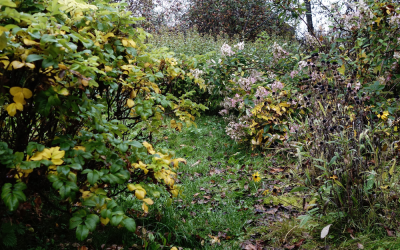Hedge trimming is more than a mere landscaping task; it is a fundamental component of responsible property care and environmental stewardship. By maintaining the form and health of hedges, property owners can significantly enhance the aesthetic appeal, functional value, and ecological benefits of their outdoor spaces. And there’s also a practical aspect if that hedge lines public spaces.
The UK is home to a wide variety of hedge types, so we’ve compiled a list of general benefits of hedge trimming that applies broadly to all varieties.
1. Enhancing Property Aesthetics
1.1 Creating Visual Appeal
A neatly trimmed hedge provides a polished appearance that elevates the overall charm of a property. The clean lines and balanced shapes contribute to a refined landscape design. This is not always important for conscientious homeowners but also businesses and organisations who want to present the right image.
1.2 Crafting Architectural Greenery
Hedges can be artistically shaped to create structured green walls, arches, and topiary masterpieces. These elements introduce sophistication and personalized style to gardens and yards or it could just be a bit fun/a talking point.
1.3 Seasonal Beauty Maintenance
Regular trimming ensures that hedges remain vibrant throughout the changing seasons, preventing them from looking unruly or neglected. Trimming the right amount, and at the right time of year, is vital to promote growth.
2. Promoting Plant Health
2.1 Encouraging Healthy Growth
Pruning stimulates new growth by allowing sunlight and air to penetrate deep into the foliage. This promotes a robust and flourishing hedge.
2.2 Preventing Disease and Pest Infestation
Removing dense, overgrown areas reduces the risk of fungal diseases and pest infestations that thrive in poorly ventilated environments.
2.3 Eliminating Dead or Damaged Branches
Trimming away dead or diseased branches helps maintain the plant’s vitality, redirecting its energy to healthier parts.
3. Environmental Benefits
3.1 Providing Habitat for Wildlife
Hedges offer shelter and nesting spaces for birds and small mammals, fostering biodiversity in urban and suburban environments.
3.2 Supporting Pollinator Populations
Flowering hedges attract bees, butterflies, and other vital pollinators, which are essential for maintaining ecological balance.
3.3 Improving Air Quality
Well-maintained hedges act as natural air purifiers, capturing dust, pollutants, and carbon dioxide while releasing oxygen.
3.4 Reducing Noise Pollution
Strategically placed hedges can serve as natural sound barriers, dampening noise from roads, neighbours, or other external sources. The dense foliage absorbs and deflects sound waves, creating a quieter and more serene environment.
4. Increasing Property Value
4.1 Boosting Curb Appeal
A visually appealing landscape with manicured hedges enhances the first impression of any property.
4.2 Demonstrating Landscape Maintenance
Well-trimmed hedges signal to potential buyers that a property is cared for, increasing its marketability.
4.3 Creating Functional Spaces
Hedges can define outdoor living spaces, providing privacy and structure that increase a property’s usable area.
5. Ensuring Safety and Security
5.1 Improving Visibility
Trimming hedges near driveways and walkways improves visibility, reducing the risk of accidents.
5.2 Reducing Hazards from Overgrown Branches
Overgrown branches can pose a threat to pedestrians and vehicles; regular trimming mitigates these dangers.
5.3 Enhancing Perimeter Security
Neatly maintained hedges discourage intruders by removing hiding spots and maintaining clear sightlines.
6. Managing Growth and Size
6.1 Controlling Hedge Spread
Routine trimming prevents hedges from encroaching on pathways and neighboring properties.
6.2 Maintaining Ideal Heights
Keeping hedges at an appropriate height ensures they remain manageable and aesthetically pleasing.
6.3 Shaping Hedges to Fit Landscape Design
Strategic trimming allows for the integration of hedges into the landscape’s overall design.
7. Energy Efficiency Benefits
7.1 Windbreaks and Shelter
Hedges can act as natural wind barriers, protecting homes and reducing energy consumption in colder months.
7.2 Natural Insulation
Strategically placed hedges provide shade and reduce heat absorption, promoting energy efficiency during warmer seasons.
8. Tools and Techniques for Effective Hedge Trimming
8.1 Choosing the Right Tools
Selecting high-quality shears, trimmers, and protective gear ensures efficiency and safety during hedge maintenance.
8.2 Manual vs. Electric Trimmers
Manual tools offer precision for detailed work, while electric trimmers are ideal for larger areas requiring rapid shaping.
8.3 Proper Trimming Techniques
Trimming hedges in a tapered shape—wider at the base than the top—prevents shading and ensures even growth.
9. Best Practices for Hedge Trimming
9.1 Timing and Frequency
Trimming frequency varies by plant species, but regular maintenance during the growing season is essential.
9.2 Understanding Different Hedge Types
Recognizing the growth patterns and needs of evergreen versus deciduous hedges ensures appropriate care.
9.3 Avoiding Common Trimming Mistakes
Over-trimming and incorrect shaping can damage plant health; careful planning and technique are key.
10. Sustainable Hedge Trimming Practices
10.1 Composting Trimmings
Turning hedge trimmings into compost reduces waste and enriches soil quality.
10.2 Using Eco-Friendly Tools
Battery-powered and manual tools minimize emissions and environmental impact.
10.3 Encouraging Biodiversity
Maintaining hedges in a way that preserves natural habitats supports local ecosystems.
When and how to trim the hedge on your property?
Regular hedge trimming is a vital aspect of property maintenance, blending aesthetic appeal with functional benefits and environmental stewardship. By investing in thoughtful and strategic trimming practices, property owners can enjoy thriving landscapes that enhance their homes and communities.
But when do you need to do it, and what’s the best technique?
If you’re not sure, then get in touch with Elm House Tree Services for a free quote, we cover throughout the North West, including Altrincham, Bolton, Cheadle, Chorlton, Didsbury, Hale, Middleton, Prestwich, Radcliffe, Stockport, Stretford, Trafford Urmston, Whitefield…and more!



